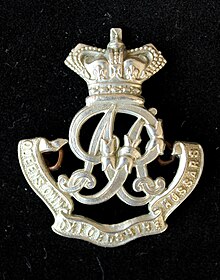Oxfordshire Yeomanry
| Queen's Own Oxfordshire Hussars | |
|---|---|

cap badge
|
|
| Active | 1888–1922 |
| Country | Britain |
| Branch | Army |
| Type | Yeomanry |
| Role |
Cavalry World War I Artillery World War II Signals Port Maritime Present |
| Size | Squadron |
| Part of | Royal Logistics Corps |
| Garrison/HQ | Banbury |
| Nickname(s) |
Queer Objects On Horseback Agricultural Cavalry |
| Colors | Mantua Purple |
| Engagements |
South Africa 1900–1901 World War I Messines 1914 Armentières 1914 Ypres 1915 St Julien Bellewaarde Arras 1917 Scarpe 1917 Cambrai 1917–18 Somme 1918 St Quentin Lys Hazebrouck Amiens Bapaume 1918 Hindenburg Line Canal du Nord Selle Sambre France and Flanders 1914–18 World War II No battle honours were awarded. It is tradition within artillery units that the Regiment's guns represent its colours and battle honours. |
| Website | oxfordshireyeomanry |
| Commanders | |
| Colonel of the Regiment |
Winston Churchill |
The Queen's Own Oxfordshire Hussars was the designated name of a Yeomanry regiment of the British Army between 1888 and 1922. In response a call by the government for troops of volunteers to be formed in the shires, meeting of "Nobility, Gentry, Freeholders and Yeomanry" was called at the Star Inn in Cornmarket, Oxford in 1794. This led to the formation in 1798 of a troop of yeomen known as the County Fencible Cavalry at Watlington, Oxfordshire in 1798. Renamed several times before becoming the QOOH, it saw service in the Boer War with 40 and 59 Companies of the Imperial Yeomanry and also served in Belgium and France during the Great War. In 1922, the regiment became part of the Royal Artillery. In 1998 it celebrated its bi-centenary by being granted the Freedom of Banbury.
Francis Spencer, 1st Baron Churchill, brother of the 5th Duke of Marlborough, consolidated some of the original independent troops of yeomanry into a regiment in 1818. George Spencer-Churchill, 6th Duke of Marlborough took over the command himself in 1845, and the Churchill family continued this close personal connection with the QOOH well into the 20th century.
Blenheim Palace provided a fitting background for annual camps and spectacular full-dress parades, while the dukes gained personal prestige from their patronage of a yeomanry regiment, and the regiment benefited from their wealth and influence. It was not unusual for several Churchills to be in the regiment at the same time.
Charles Richard Spencer-Churchill, 9th Duke of Marlborough was commissioned in 1892 as a humble Cornet, and was an officer for many years, including service with the Imperial Yeomanry during the Second Boer War. He finally became Lieutenant-Colonel in command of the regiment from 1910 to 1914.
...
Wikipedia
